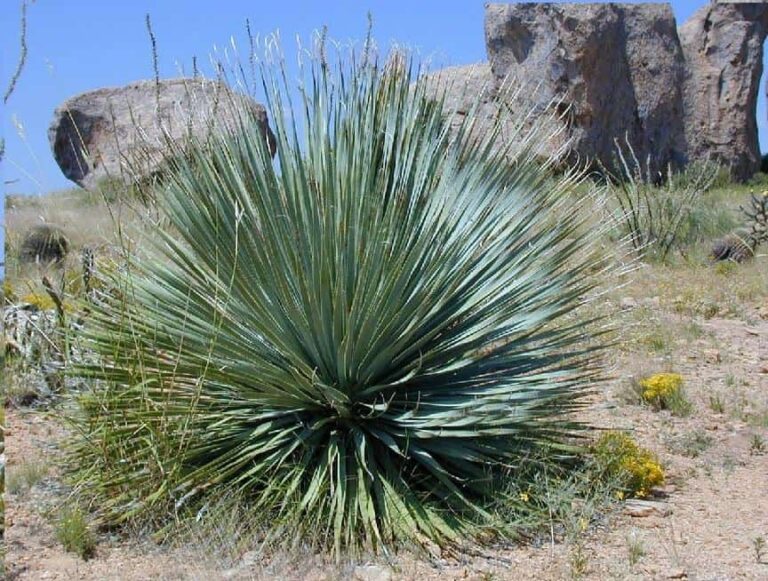Pilea Peperomioides Care: The Ultimate Guide
Pilea peperomioides is undoubtedly one of the most popular indoor plants out there.
These plants are pretty popular when you hear other names such as Chinese money plant, UFO plant, coin plant, and pancake plant now and then.
Despite its popularity and household status, many people are confused about caring for a Pilea peperomioides plant.
On the bright side, having confusion and doubts is a better thing than taking the whole Pilea peperomioides care for granted.
Anyway, in this article, we have prepared the ultimate guide to take you through Pilea peperomioides care.
We will start with a brief introduction to the plant itself.
What Is Pilea peperomioides?
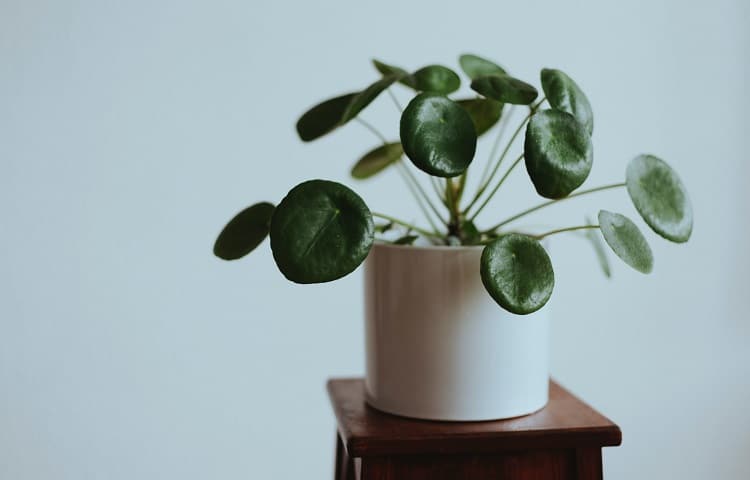
Pilea peperomioides is one of the most popular indoor garden plants that you can find today.
Native to China, this plant is also known as the Chinese money plant and coin plant, among other names.
However, if we look at it from a botanical perspective, Pilea peperomioides belong to the Evergreen perennial plant type. It can get as tall as 12 inches when in the mature phase and comes with a few requirements.
Compared to other indoor/outdoor garden plants, the Pilea peperomioides plant does not require too much attention from your side.
It can reach its complete growth stage if you provide the recommended environment for survival. Nevertheless, you cannot take the plant for granted. Simply putting it near the window cannot give you those stunning Chinese money plant visuals you have seen in photographs.
It is why you need to consider aspects such as water requirement, sufficient sunlight, use of fertilizers, proper repotting styles, etc. We also understand that you may have a few doubts regarding the adequate growth of the plant.
Fortunately, we have included all these aspects in the guide below. Therefore, you would not miss the point.
Water
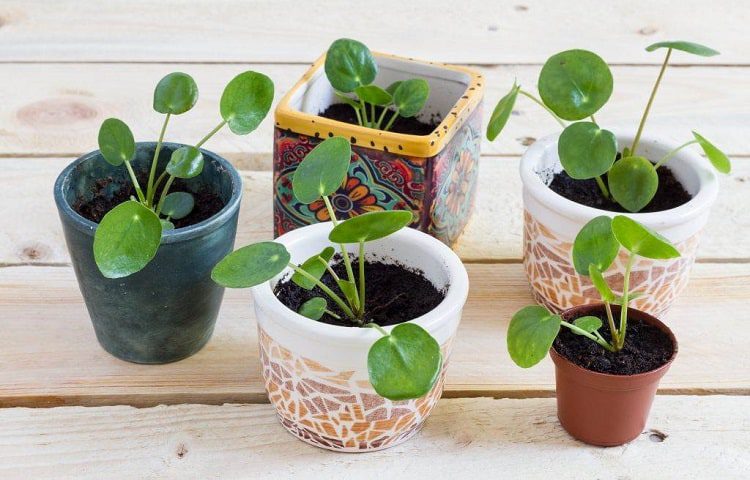
As we said, Pilea peperomioides belong to the category of Evergreen perennials, which tend to survive with a minimal amount of water.
Similarly, during the Pilea peperomioides care, you do not have to be aggressive about watering the plant. Instead, you should keep the plant under constant supervision.
If you did not know, Pilea peperomioides is one of those plants that tell you what is wrong.
As the general watering routine for the plant, you can add water to the pot once in two weeks. However, it should not make the soil soggy by any chance.
It means you must maintain a healthy balance between the dryness and wetness of the ground. If you put the Pilea peperomioides plant outside, though, you may have to optimize the watering schedule during the spring or summer seasons.
On the other hand, if you believe the moisture in the air is good enough for the plant, you can tone down the frequency of watering.
When the Pilea peperomioides plant does not get enough water, its leaves become droopy. Considering that the plant has typically bright leaves, you can spot this droopiness quickly.
If you see this droopiness often, it is recommended to increase the watering schedule. While this is the right way, you must ensure a few other things while watering Pilea peperomioides.
- You should ensure that the pot has a correct drainage system. Experts recommend that at least 20% of the water you pour into the pot must find its way through the drainage hole.
- We recommend using dechlorinated water or rainwater to care for the Pilea peperomioides plants. It is unnecessary to buy dechlorinated water; instead, you can filter the tap water.
- Please keep in mind that the temperature inside your house may have an unspecified impact on the plant. Therefore, you should always keep an eye out.
Sunlight
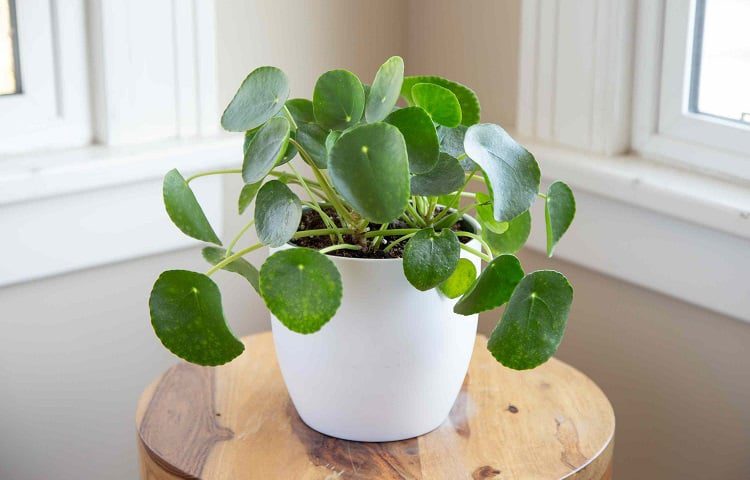
Like every other plant, Pilea peperomioides also require sunlight to grow.
However, it does not mean putting the plant on the window always stands with direct sunlight exposure. Instead, it is a little complicated.
- As per the biological classifications, the Pilea peperomioides plant does not need too much sunlight. Of course, it needs a considerable amount of sun, but it must be delivered in the right amount as well as proportion.
- You can expose the Pilea peperomioides plant to direct sunlight, but it must be done for only a few hours per day. For instance, if you put the plant under direct sunlight during a hot summer afternoon, you may end up burning the leaves and ruining the plant’s life.
- Ideally, it is not a great idea to keep the Pilea peperomioides plant in the dark. It may hinder the full growth potential, and you may see the leaves drooping. Therefore, you can place the pot near one of your windows in Eastern exposure.
Eastern exposure refers to placing the plant faced to the east. Therefore, when the sun rises, the plant can absorb the right amount of sunlight.
However, this placement would not cause too much sunlight exposure during the noon/afternoon time, either. The second-best option you can consider is called Western exposure.
As you can guess, your plant would face the West direction, and the plant can absorb the required amount of sunlight during mid-afternoon and evening.
However, compared to the Eastern exposure mode, Western exposure would provide more bright light. We recommend that you choose between these two options for the best growth patterns of your Pilea peperomioides plant.
However, if you cannot choose these methods, you can optimize the plant for indirect sunlight. You can do this by moving the Pilea peperomioides plant farther away from the window. So, even though it will get sunlight exposure, it will not be too hot.
Alternatively, you can consider adding a filter to your window if you think direct sunlight exposure affects the plant’s growth. The other option will be to get one of the supplemental light systems out there.
We recommend it if you want to place the plant on your tabletop, far away from the window. Since the popular Pilea peperomioides varieties have gotten used to these light systems, you can expect the Chinese money plant to grow without trouble.
Fertilizer
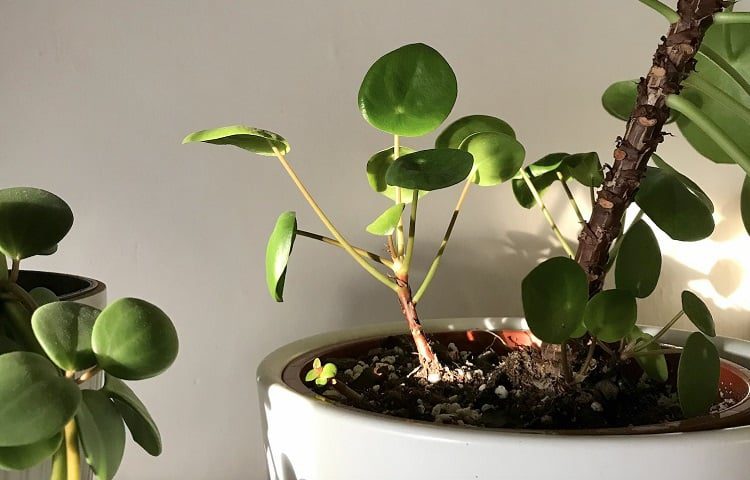
During Pilea peperomioides care, you must take a strategic approach towards fertilization. Absolution is not the idea here.
However, it would help if you understood how a certain amount of fertilizer impacts the plant and act accordingly. As for the fertilizer that you can choose, one of the organic houseplant fertilizers would do the job.
But, how and how often you apply the fertilizer is more important. Here are some general guidelines.
- You should limit the fertilization of the Pilea peperomioides plant to once a month or fewer. The best idea will be to fertilize the plant once a month and look for the impact. If you see salt buildup on top, it means you are adding too many fertilizers to the pot.
- You should always arrange fertilization to follow the watering day. If you add fertilizers — even the most organic ones — to a dry pot, it will do more harm than good. Therefore, the soil in the pot must be able to absorb the fertilizer liquid you pour into the pot the next day.
- When you get the organic houseplant fertilizer, you must not introduce it directly to the pot. Instead, make sure you dilute the same into half its power. Therefore, the included water will help the growth element to travel deep.
- You should also limit fertilizers when the plant is actively growing. For Pilea peperomioides, it will be the spring and the fall season. If you put the fertilizer during the remaining months, you might waste the fertilizer and harm the plant.
You should consider your Pilea peperomioides plant as a growing child. It is not a good idea to always provide only the most optimized nutrients, correct?
Similarly, it would help if you let the plant grow in the way it usually should. However, during the best periods of growth, you can add a considerable amount of fertilizer to boost the process.
Repotting
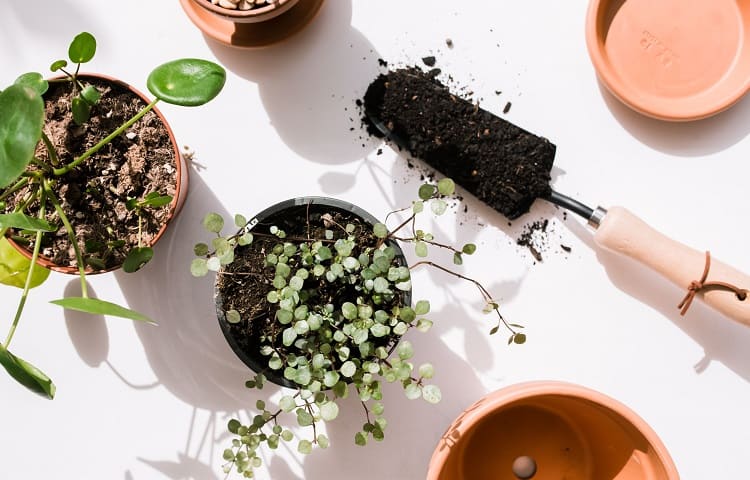
Before we talk about repotting, you should understand the most appropriate potting scenarios for the Pilea peperomioides plants.
When you purchase the plant for the first time, you may have it delivered in a pot of terracotta construction. However, it is not ideal for the growth of the Pilea peperomioides plant. Therefore, you must choose a plastic pot or a ceramic container to grow the plant.
You must also ensure that the container has a drainage hole. Adding too much water and sogging the soil is one of the worst things you can do to a Pilea peperomioides plant.
You should also have a contraption that removes the drained-out water from the bottom position. By doing so, you can avoid the situation of rotten roots at the bottom.
If you have taken care of the things we have mentioned above, repotting your Pilea peperomioides plant will be an easy affair. You can plan yearly repotting during the early spring or summer season.
The idea here is to refresh the soil and improve the rooting performance of the plant. If you think your Pilea peperomioides plant is getting bigger, you may have to obtain a larger container.
In case you find too many offshoots in the current pot, you may consider removing some of them as well. It will come in handy when you want to propagate the Pilea peperomioides plants or help a friend.
In all these instances, the primary idea is to ensure good air circulation within the pot. Only then can you expect the system to show the maximum growth potential.
Please keep in mind that you may have to increase or decrease the watering frequency based on the pot you have moved the plant to.
For instance, if the new container uses a material that absorbs water, the Pilea peperomioides plant may not receive the required amount of water. On a brighter note, you can always look at the leaves and tell if the plant is growing as it should.
Frequently Asked Questions
Here are some of the most frequently asked questions about Pilea peperomioides care.
Some of the issues we have mentioned below may occur to you based on where you live and the type of Pilea peperomioides you have chosen.
How do you take care of a Pilea plant?
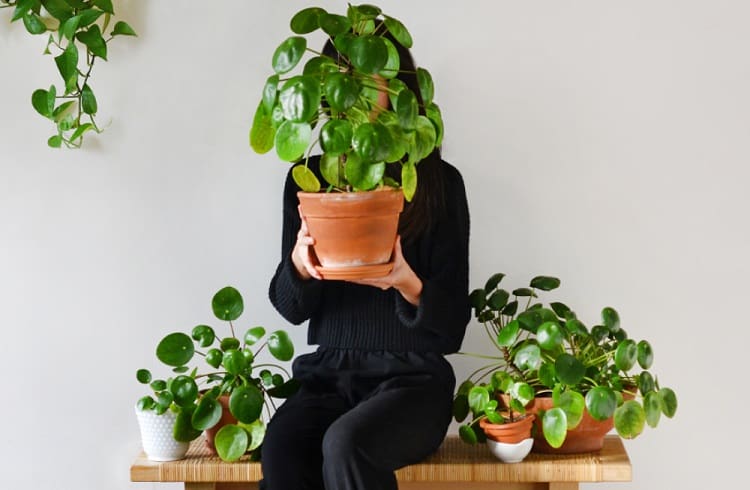
Taking care of a Pilea peperomioides plant is a relatively easy task. It does not mean that you can take these actions for granted, though.
The first step to take care of a Pilea plant is to understand the characteristics of the plant. You must understand the right amount of water and sunlight you want.
It is also wise to use a pot to supplement the plant’s growth. An equally important aspect would be the type of soil that will be housing the Pilea peperomioides.
The ground must not have extreme pH levels to begin with. It should not also have many chemicals that may interfere with the plant’s growth.
Instead, it would help if you went for something more stable and sustainable. Once you have passed this step, you can place the Pilea peperomioides plant in the pot and position it in a place that provides you a decent amount of sunlight.
After that, you have to water the plant every week, especially during the summer and spring seasons. Once a year, you may also have to repot the Pilea peperomioides plant so that you can ensure the best speeds of growth and get rid of potential problems.
As you can see, you do not need Rocket Science to take care of a simple Pilea peperomioides plant.
How much sun does a Pilea need?
As you probably know, we cannot measure the amount of sunlight required by the plant. Here is a simple estimate you can follow, though.
A typical Pilea plant needs a few hours of daylight every day. However, you have to choose these three hours wisely. The best option is to arrange your Pilea plant in the East direction and let the plant absorb sunlight during the first few hours of sunrise.
This light would not be too bright and will never impact the plant’s health. Alternatively, you can expose the plant to the sunlight you get in the evening, but you will have to cut down the number of hours.
If you are wondering, it is possible to grow a Pilea peperomioides plant without direct sunlight. You can choose one of the supplemental light systems for house plants.
These systems provide the suitable amount of light that a Pilea peperomioides plant can use. However, we will recommend this option only if you live in a place without windows or a balcony.
Does Pilea like to be misted?
People mist their plants to increase the amount of humidity. However, it will not be necessary in Pilea peperomioides plants.
It happens because a typical Pilea peperomioides plant can survive in a dry atmosphere without a problem. Nevertheless, by increasing the humidity in the environment, you can add some speed to the growth.
Then, again, you will have to mist the plant quite regularly. To answer the main question, Yes. Most Pilea likes to be misted.
How long do Pilea plants live?
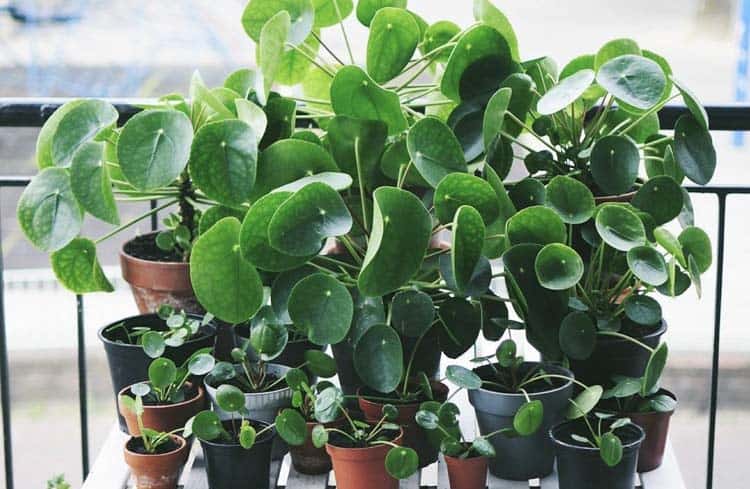
Pilea peperomioides belong to a category of plants that can live for extended periods. Even though the results depend on how you care for the plant, you can expect a Pilea plant to last for up to 10 years.
As you can guess, it is an excellent figure for anyone. However, we should also mention that some growers of Pilea have managed to increase the plant’s lifespan to up to a whopping 20 years. Of course, you will need a complete set of tools and resources to reach that figure.
In general, though, the Pilea peperomioides plant will last longer than the typical indoor garden plants you come across. The best part? You can achieve these great numbers without being super-careful about the plant.
How can I make my Pilea grow thicker?
If your Pilea peperomioides plant is not thick as you want it to be, there could be several reasons. First and foremost, the plant may not have access to the correct number of resources, such as sunlight, water, or a proper fertilizer.
Therefore, the first step to making your Pilea grow thicker is to ensure that the plant is in the right environment. You can even consider exposing the plant to better sunlight, but not direct sunlight.
As we mentioned earlier, you can add an organic fertilizer to the pot during the plant’s growth period. It can not only speed up the growth process but also help the plant to acquire more resources.
How to get rid of Pilea pups?
Getting rid of the Pilea pups from a pot is an easy task. However, if you skip this task, you may have a too-much-Pilea-in-a-pot situation in front of you.
Therefore, as soon as you see too many Pilea pups in the pot, you can remove the unwanted ones from the mother plant.
Even though you can use forceps or other tools from the gardening toolkit, you can reach similar results using your fingers. After this, you can either grow the pups in another container or dispose of them.
Conclusion
We have covered everything you should know about Pilea peperomioides care in the different parts of the article.
Now, you have to keep looking at the individual aspect and make the right decision. You must keep in mind that overdoing these steps or providing too many resources would not speed up the growth process.
Given that a typical Pilea peperomioides plant would last for up to 10 years, a steady supply would be the best choice.

